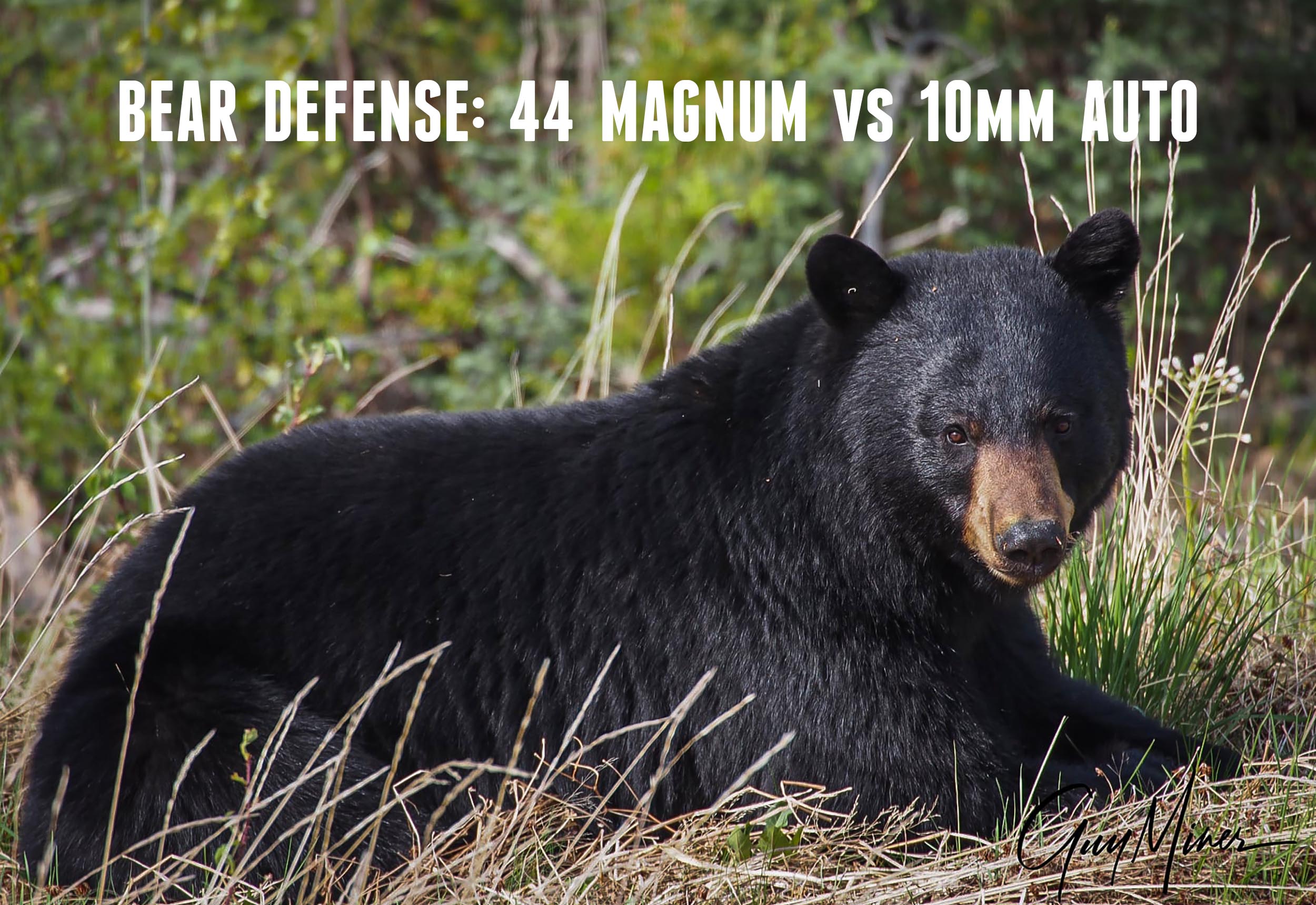What would you want against a bear, 10mm Auto or .44 mag? That’s what we’ll cover in this story!
Disclaimer
Ultimate Reloader LLC / Making with Metal Disclaimer: (by reading this article and/or watching video content you accept these terms). The content on this website (including videos, articles, ammunition reloading data, technical articles, gunsmithing and other information) is for demonstration purposes only. Do not attempt any of the processes or procedures shown or described on this website. All gunsmithing procedures should be carried out by a qualified and licensed gunsmith at their own risk. Do not attempt to repair or modify any firearms based on information on this website. Ultimate Reloader, LLC and Making With Metal can not be held liable for property or personal damage due to viewers/readers of this website performing activities, procedures, techniques, or practices described in whole or part on this website. By accepting these terms, you agree that you alone are solely responsible for your own safety and property as it pertains to activities, procedures, techniques, or practices described in whole or part on this website.
Bear Attacks
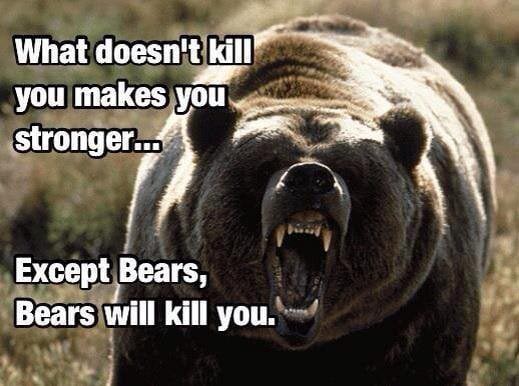
The subject of bear attacks and bear defense often stirs up a lot of interest and emotion. Great discussions and arguments, particularly online, have ensued when the subject comes up. While bear attacks are relatively rare for the general population, I contend that they’re not all that rare for people who venture into “bear country.” Across all records of attacks, several scenarios seem to repeat themselves.
One, someone inadvertently gets too close to a bear, perhaps while hiking, and the bear reacts defensively. The classic scenario is a sow with cubs, but any bear can react defensively if approached too closely.
Bears, particularly grizzlies, are known to stay near an animal carcass and defend it from other bears, wolves, and even people. Hunters approaching their downed elk or deer in bear country should be cautious.
Then there’s the predatory bear. This can be a black bear or a grizzly. The bear actually stalks a person for the purposes of killing and eating them! Yes, this happens.
Fortunately most bear attacks are not fatal, but a mauling can leave you with not only a story but serious injuries.
Bear Defense
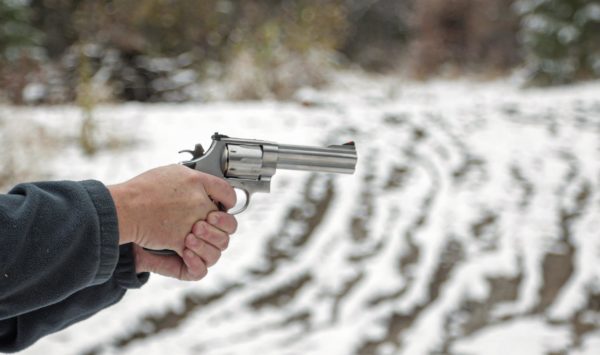
There are many tips for avoiding bear attacks, but they can be found elsewhere. Here we are discussing two popular handguns and cartridges for bear defense. Some don’t see the need for a firearm, considering bear spray the answer. It does work, most of the time, just like firearms. There are wildly conflicting “studies” online, some touting bear spray as the best solution, others claiming firearms are the way to go.
Let’s first dispense with a few false notions about bears. Bears are not endangered — not even close. Over 30,000 black bears live in Washington alone. Though grizzlies are still protected in the lower 48 states, their population has increased dramatically in the Greater Yellowstone Ecosystem over the past 50 years and continues to grow. They’ve been pushing out from their stronghold in Yellowstone and have been seen out on their old range, even onto the plains. This has not been without conflict with humans. There is currently no legal grizzly bear hunting opportunity in the lower 48, but you can legally defend yourself against an attack.
Alaska’s grizzly population is carefully managed and some hunting is allowed. Seeing a bear in Alaska is not a rare occurrence.
Some say that bear meat is inedible and puts humans at risk of disease. Bear meat is not only edible, it can be very good! Prepare it properly and cook it sufficiently to eliminate the possibility of trichinosis. Bear back straps can yield excellent “pork chops.”

I’ve only shot four black bears and one grizzly, but have been on hand to see one more grizzly and several more black bears taken by hunters. I’m no expert, but I remain fascinated by bears and with hunting them. I’m also always aware of the possibility of an attack while hiking, hunting or fishing.
Why a handgun?
Unlike a rifle, it’s easy to have a handgun readily available on the body while fishing, field dressing game, chopping wood, cooking, setting up a tent or any number of other activities. A rifle generally has more power and is easier to shoot well, but the handgun is there when needed. It’s really a question of which handgun to choose. Whichever you select, be sure to practice with it! Practice drawing it from the holster and getting off quick, accurate shots. Today I’m comparing two choices, a 10mm GLOCK and a .44 Magnum.
44 Magnum S&W
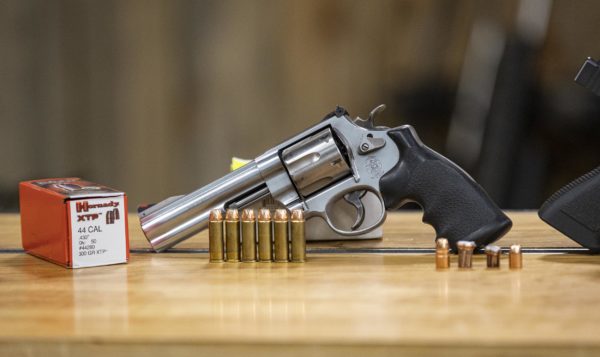
Big bore revolvers have been used by American outdoorsmen for generations. For a long time, the standard answer to anyone seeking a big bore revolver for bear defense was “44 magnum.” It was popular, ammunition and reloading components were available, and several different firearms manufacturers offered 44’s with various weights and barrel lengths.
Revolver fans owe wheelgun legend Elmer Keith for pushing major manufacturers into producing 44 magnum ammunition and revolvers.
The recoil of a “normal” weight 44 magnum with full power loads is significant. This means slow recovery times between shots. A handgunner can learn to handle those loads, but it might not be an easy task. Reloading a single-action revolver is terribly slow, but a double action revolver can be reloaded pretty quickly by use of a speedloader.
44 magnum revolvers such as Ruger’s Redhawk and Super blackhawk, as well as S&W’s Model 29 and 629, tend to be a bit bulky and heavy. My 5” 629 weighs 44.7 ounces unloaded. (There are also 4” and 6” models, but the 5” is a nice compromise and not as hard to carry or conceal compared to the six-inch.)
There are also a few exceptions, like the S&W 69 and the S&W 329. The 329 has a lightweight alloy frame to achieve a weight similar to the 10mm Glock. The 69 is a five-shot 44 built on the mid-sized L-frame.
Though there are more powerful revolver rounds, the 44 magnum remains as stout as ever. Other larger and more powerful revolver rounds include the 454 Casull, 480 Ruger and of course the 460 and 500 S&W magnums.
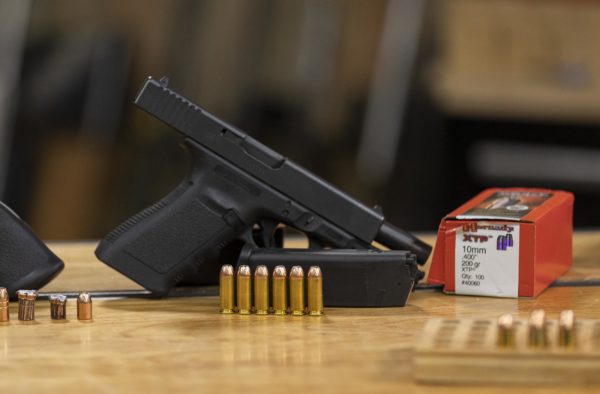
10mm Glock 20
Semi-automatic handguns have become more popular for bear defense in recent years. This is partly due to the renewed interest in the powerful 10mm cartridge and readily available firearms chambered in it. The GLOCK and various 1911 designs are popular choices for this caliber. Colonel Jeff Cooper was responsible for the initial interest in the 10mm cartridge in the 1980’s.
Advantages of the semi-auto are increased ammunition capacity, a compact flat profile and less recoil. They also typically weigh less and carrying an additional magazine is easy. The GLOCK 20 we’re testing has a 4.6” barrel, not much shorter than the 5” 44 Mag, a 15 round magazine and weighs 27.5 ounces unloaded, much lighter than the 44. According to GLOCK’s website, a loaded magazine will up the weight to approximately 39 ounces.
The 10mm itself has been around for several decades, so ammunition is out there, including factory loads intended for hunting and bear defense. Handloading is also always an option!
*It’s worth noting that famous Alaskan brown bear guide Phil Shoemaker used his compact 9mm to kill a large brown bear that attacked him and his fishing clients at short range just a few years ago. He credited the deep penetration of the heavy hard cast ammunition he was using with the kill, but I think Phil’s vast experience with brown bears also played a role. No matter the caliber or gun, shot placement is vital!
Capacity
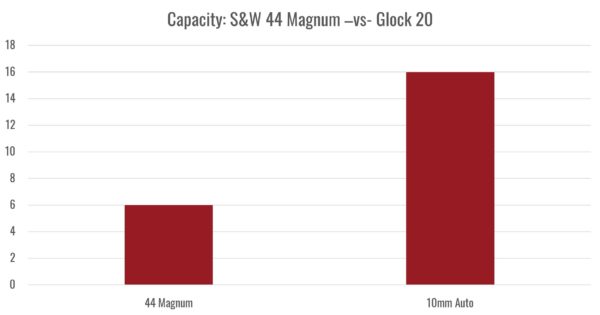
Ammo capacity of the two guns is very different. Although six rounds of the revolver is nothing to sneeze at, the sixteen rounds carried in the semi-auto makes a huge difference. The GLOCK 20 has 267% the capacity of a 6-shot revolver. This could be a deciding factor.
Metrics and Ballistics
For our comparison between the two rounds, we chose to use the well respected Hornady XTP hollow point bullets for each. (We are aware that hard cast and full metal jacket bullets penetrate deeper, and we’ll be doing an article on that in the future.)
Hornady’s XTP is an expanding handgun bullet known for excellent penetration. By using the heaviest XTP’s for each cartridge, we hoped to maximize penetration.
From Hornady:
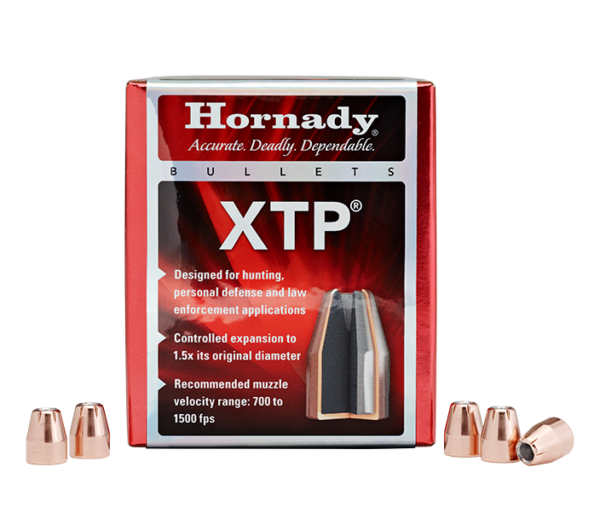
Designed for hunting, self-defense and law enforcement applications, the XTP® bullet demonstrates the kind of accuracy that led many competitive shooters to adopt it. Reliable performance makes the XTP® the most popular handgun bullet for both target shooters and hunters. But it’s the stopping power of the XTP® bullet that has truly built its world-class reputation. From the onset, XTP® bullets were specifically designed to expand reliably at a wide range of handgun velocities to deliver deep penetration with every shot.
I loaded each to max or near max according to Hornady’s reloading data.
Load Data:
- 10mm 200 gr XTP, 7.1 grains CFE Pistol at 1060 fps
- 44 mag 300 gr XTP, 17.5 grains H110 at 1093 fps
The 10mm is a true .400” caliber whereas the 44 actually measures .429” diameter.
Interestingly enough, there was little velocity difference between the loads even with just over 10 more grains of powder in the 44 mag. The temp was hovering around freezing when we conducted the tests and may have slowed the potential velocity.
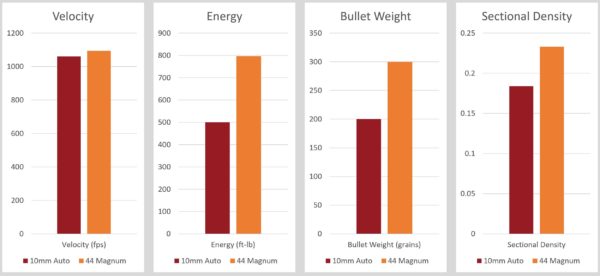
In terms of foot pounds of energy, the extra 100 grains of bullet from the 44 magnum made its presence known. Clearly the 800 ft-lbs of the 44 is superior to the 500 ft-lbs of the 10mm by looking at the numbers. The question remains, does this really make much difference in the field against bears?
Speed
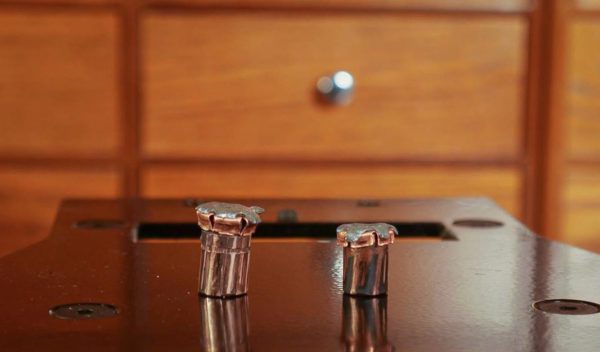
Looking to test speed, I fired three shots from each handgun at a steel silhouette at close range. Disclaimer: I seldom shoot a GLOCK and hadn’t shot a 10mm GLOCK in nearly three years. Even so, I put three hits on target more quickly with the GLOCK than I could manage with my much more familiar 44 magnum revolver. We timed the three shots and the 44 magnum took 67% longer to fire compared to the 10mm.
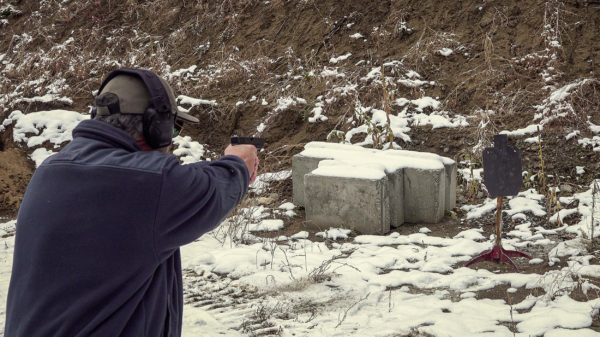
Ballistics Gel Analysis


I fired one shot from each gun at 5 yards, a reasonable bear defense distance. The 10mm penetrated well, coming to rest at 20” in the ballistic gel blocks. The 44 penetrated an additional ten inches! This is another win for the bigger bullet. The temporary wound channel diameter was roughly the same for both bullets (approximately 4.5”) which somewhat surprised me.
We weighed and measured the recovered bullets to find these tough Hornady XTP bullets barely lost any weight!
The 200 grain 10 mm bullet weighed 197.5 grains and measured .531” in diameter. The 300 grain 44 mag weighed 297.0 grains and measured .586” in diameter.
Conclusion
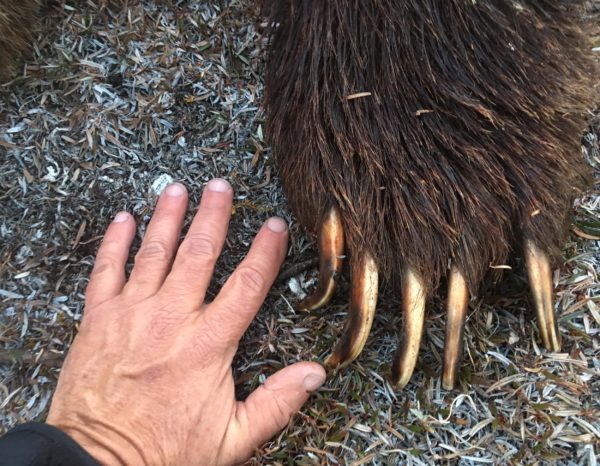
The tradeoffs are clear. The 44 magnum holds a power advantage over the 10mm semi-automatic, but the 10mm GLOCK crushes the revolver in terms of ammunition capacity and speed of follow-up shots. The GLOCK is also lighter and easier to carry. One other consideration is if you are pressed against a bear, the semi-automatic could go out of battery. It’s also a question of whether everything would feed and function correctly. GLOCKs are particularly reliable, but it’s still something to think about.
Both of these guns are grab and go. Neither have safeties.
Actual defensive use against bears has proven either cartridge can prevail against a bear as long as the shots are well-placed into the vitals.
Between the two, I’d recommend carrying the handgun you’re most comfortable with and handle the best.
When I’m in grizzly country, such as while fishing in Alaska, I’m often near huge coastal brown bear. Under these conditions, I’m more attracted to the power of the 44. I also like it while hiking and camping solo near Yellowstone for fly fishing and wildlife photography. When I’m hiking in the Washington Cascades, there are many black bear, but grizzlies are few and far between. Given the size difference between the two, I’m comfortable carrying a smaller firearm in Washington suitable for black bear, such as a 357 magnum revolver. Both the 10mm semi-automatic and 44 magnum revolver are powerful self-defense handguns.
Keep in mind these are not the only two firearms suitable for bear defense. Other options include other powerful handgun rounds, rifles, and the ubiquitous 12 gauge shotgun.
Get the Gear
Find Hornady XTP bullets at Midsouth Shooters Supply!
Hornady 10mm .400 Diameter 200 grain XTP
Hornady 44 Caliber .430 Diameter 300 grain XTP
Don’t miss out on Ultimate Reloader updates, make sure you’re subscribed!
Thanks,
Guy Miner
